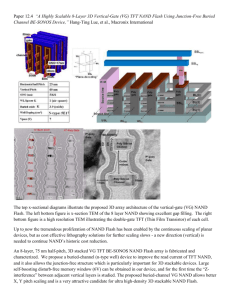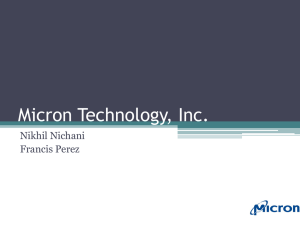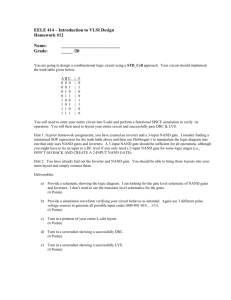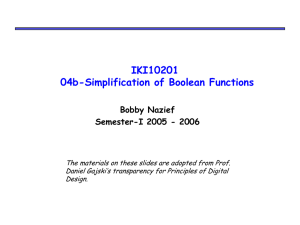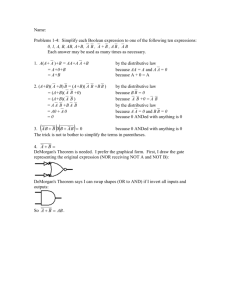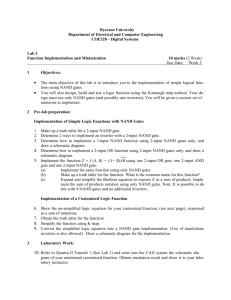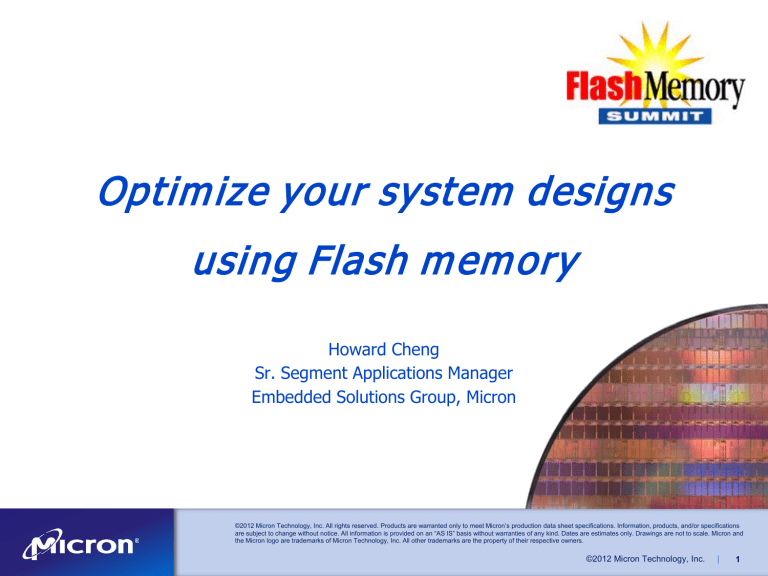
Optim ize your system designs
using Flash m em ory
Howard Cheng
Sr. Segment Applications Manager
Embedded Solutions Group, Micron
©2012 Micron Technology, Inc. All rights reserved. Products are warranted only to meet Micron’s production data sheet specifications. Information, products, and/or specifications
are subject to change without notice. All information is provided on an “AS IS” basis without warranties of any kind. Dates are estimates only. Drawings are not to scale. Micron and
the Micron logo are trademarks of Micron Technology, Inc. All other trademarks are the property of their respective owners.
©2012 Micron Technology, Inc.
|
1
Agenda
▶ Non-Volatile Market & Trends
▶ Flash Cell Architectures
▶ Flash Memory Choices
▶ System Considerations
▶ Summary
©2012 Micron Technology, Inc.
|
2
2012 Semiconductor Market Forecast
Worldwide Semiconductor Market
$313B
DRAM $32.1B
PC
Specialty
$12.4B
$19.7B
Flash $32.4B
NOR
$3.9B
NAND
$28.5B
Source: Gartner 3Q11
©2012 Micron Technology, Inc.
|
3
The Embedded Markets
NOR: %Revenue – 2011 $2.2B
NAND: %Revenue – 2011 $1.7B
PC &
Automotive Server
6%
6%
PC & Server
26%
Consumer &
Graphics
27%
Automotive
10%
Industrial
13%
Networking &
Storage
7%
Industrial
20%
Consumer &
Graphics
61%
Networking &
Storage
24%
Source: Gartner/iSuppli/Micron 2011
©2012 Micron Technology, Inc.
|
4
Embedded Flash Technology Trend
100%
Managed NAND
90%
NAND
80%
# Units
70%
60%
M-NAND
50%
NAND
Serial NOR
40%
S-NOR
P-NOR
30%
20%
10%
Parallel NOR
0%
2011
2012
2013
2014
2015
NAND growing in units with managed NAND coming on strong for ease of design
NOR uses still versatile, but parallel losing popularity due to board simplicity
Source: iSuppli, Mkt research, does not include large data applications (ie PMP, MP3, SSD, Media Cards, etc)
©2012 Micron Technology, Inc.
|
5
Embedded Flash Technology Trend
% MMb
Managed NAND
M-NAND
NAND
2011
2012
NAND
2013
2014
2015
% MMb
Serial NOR
S-NOR
Parallel NOR
2011
2012
P-NOR
2013
2014
2015
Code + Data bit growth increasing the need for NAND and cost/bit
Serial NOR gaining momentum on parallel due ease of design
Source: iSuppli, Mkt research, does not include large data applications (ie PMP, MP3, SSD, Media Cards, etc)
©2012 Micron Technology, Inc.
|
6
Agenda
▶ Non-Volatile Market & Trends
▶ Flash Cell Architectures
▶ Flash Memory Choices
▶ System Considerations
▶ Summary
©2012 Micron Technology, Inc.
|
7
Cell architectures
Floating Gate
Technologies
Polysilicon Gate
Polysilicon Gate
Oxide
ONO
Nitride
Electron Storage
Polysilicon
Oxide
S/D
Oxide
S/D
D
S
PCM
Technology
Temperature
T
m
Tx
Reset (amorphization)
Set (crystallization)
Time
©2012 Micron Technology, Inc.
|
8
PCM product attributes
• Available in NOR-type options
• Industry driving toward LPDDRx
• Fast programming for NVM
• Fast read capability
Evolved Options
Disruptive Options
• NOR replacement NOW
• Integrated memories NAND/RAM
• NAND replacement <5 yrs
• System Cache Options
• RAM replacement <5 yrs
HDD/SDD Integration
PCIe
©2012 Micron Technology, Inc.
|
9
PCM benefits
Bit Alterability
Scaling
0 1 0 1 0 1 0 1
No Erase Required
1 0 1 0 1 0 1 0
Endurance
90 & 45nm Today
5nm Future
Bit Errors
©2012 Micron Technology, Inc.
|
10
Agenda
▶ Non-Volatile Market & Trends
▶ Flash Cell Architectures
▶ Flash Memory Choices
▶ System Considerations
▶ Summary
©2012 Micron Technology, Inc.
|
11
Solutions for different requirements
NOR vs. NAND
Lowest
Floor Cost ($)
Serial
NOR
•
•
•
•
•
Lowest
$/GB
Parallel
NOR
Longer lifecycles
Ease of use
Diverse products
Lower Floor cost
Code, Code+Data
SLC
NAND
•
•
•
•
Managed
NAND
MLC
NAND
Shorter lifecycles
Focus on cost/GB
Expanding markets
Mostly Data Focused
Customer Requirements Dictate the Solution
©2012 Micron Technology, Inc.
|
12
NOR product attributes
• Simple command sets
• Cost effective at low densities
• Stable architectures
• Value added features (XiP, security,
quality, small data, etc)
Serial
Parallel
• Low pin counts
• Basic add/data interface
• Easy PCB routing
• Asynchronous random access
• Smallest footprint
• Synchronous burst operations
• Synchronous operations
• Higher throughput
• Cheapest low density
• Best XiP architecture
©2012 Micron Technology, Inc.
|
13
NAND product attributes
• Low pin counts
• Cheapest cost/bit at high densities
• Frequent conversions/migrations required
• Fast programming
Discrete
Managed
• Some controllers support boot
• Error management onboard
• Some standards (ONFI)
• Some controllers support boot
• Common packages
• Higher density reach
• Needs SW for error management
• Easier conversions/migrations
• Demand paging – saves bits
• Standards (MMC, USB, uSD…)
©2012 Micron Technology, Inc.
|
14
Flash Architectures – Component Level
All architectures have their advantages
Trend in the industry moving toward the lower pin count architectures
©2012 Micron Technology, Inc.
|
15
NAND technology challenges
How to manage the ECC requirements?
•
NAND controllers with high ECC capability
•
ECC NAND managed solutions
•
on-die ECC, ClearNAND
Fully managed solutions
eMMC, eUSB, others
How to manage lower Endurance?
•
Understand the application and usage model
How does the file system work?
How often are you programming?
How big is the data file/s?
What is the PLC of your system?
Determines PE Cycles and
Density Required
Intersecting your project and the memory technology is key to success!
August 12
©2012 Micron Technology, Inc.
|
16
NAND system solutions for Industry
Raw NAND for application “expert” with NAND data
management and ready to support ECC needs.
ECC NAND for application that do not want to change the
ECC with the NAND litho shrink.
Serial NAND for application requiring high density with
Host Controller I
NAND Interface
FTL
ECC
LLD
ECC NAND
NAND Interface
FTL
LLD
NAND data management with a standard interface.
eUSB interface for application that want to offload by any
NAND data management with a standard interface.
August 12
NAND BUS
ECC
SPI
Host Controller III
FTL
eMMC interface for application that want to offload by any
Raw NAND
Host Controller II
SPI Interface
Serial protocol.
NAND BUS
SPI BUS
ECC
LLD
eMMC NAND
Host Controller IV
eMMC Interface
MMC BUS
LLD
FTL
eUSB NAND
Host Controller V
eUSB Interface
LLD
ECC
USB BUS
ECC
FTL
©2012 Micron Technology, Inc.
|
17
Level of Management by NAND solutions
Level of Management by NAND Solution
Raw NAND
ECC NAND
(On-Die ECC,
ClearNAND)
Fully Managed
(eMMC, eUSB)
Complexity of
Customer Development
High
Med
Low
New Product
Qualification
High
Med
Low
Relative Cost
Low
Med
High
(NAND Management by Host)
(Complexity & Effort)
Trade offs between Complexity, Qualification Effort & Cost
©2012 Micron Technology, Inc.
|
18
Agenda
▶ Non-Volatile Market & Trends
▶ Flash Cell Architectures
▶ Flash Memory Choices
▶ System Considerations
▶ Summary
©2012 Micron Technology, Inc.
|
19
Performance considerations for system solutions
Raw NAND
Host Controller I
NAND Interface
FTL
ECC
NAND BUS
LLD
On-Die ECC
NAND
ECC
Host Controller II
NAND Interface
FTL
NAND BUS
LLD
eMMC
Host Controller III
eMMC Interface
eMMC BUS
LLD
ECC
FTL
Device Throughput
Raw NAND, ECC NAND and eMMC require different management software
The correct performance evaluation is at system
LLD = Low Level Driver
ECC = Error Correction Code
FTL = NAND Scheduling Logical Mapping, Bad Block Management, Wear Leveling
©2012 Micron Technology, Inc.
|
20
Memory subsystem designs/architecture
D$
I$
CPU
Working
Working
Static
DRAM
D$
Shadow
Working
Static
• Simple architecture
• Possible to reduce DRAM density
• Lower stand-by power
Code copied and fixed in place at boot
CPU
Data
&
Files
NAND
I$
Memory/Bus
Controller
Data
Memory/Bus
Controller
Code
Flash
Boot
NOR
“Store and Download” (SnD) Architecture
DDRx
Execute in Place (XIP) Architecture
• Complex but higher performance
• More DRAM required
• Higher stand-by power
©2012 Micron Technology, Inc.
|
21
System cost reductions and simplification
System Architecture
Software Architecture
High
Write
N+3
Critical
Data
N+2
NVM
N+1
Shadowed
Code
High Read
Memory Banks
RAM
CPU
BatRAM/nvRAM
Complimentary
I/O
E2
N
Main Memory
NOR/NAND
Boot Code
+ OS
Understand Your Usage Model
System BOM
• xRAM Usage models
• How many CE#/Banks do you use
• Can you eliminate or
partially eliminate any
unnecessary memory?
• Why might you split memory into separate chips
• Performance vs. Cost ratio
• Other system SW requirements (file system, data logging, etc)
©2012 Micron Technology, Inc.
|
22
Larger Data Fetches
©2012 Micron Technology, Inc.
|
23
Performance Comparison – Small Data
©2012 Micron Technology, Inc.
|
24
Memory technology comparison
Attributes
PCM
DRAM
NAND
NOR
EEpROM
Bit Alterable
Non-volatile
Cost
Read Speed
Write Speed
All memory technologies have their advantages
Look for ways to differentiate and stay cost effective
©2012 Micron Technology, Inc.
|
25
Agenda
▶ Non-Volatile Market & Trends
▶ Flash Cell Architectures
▶ Flash Memory Choices
▶ System Considerations
▶ Summary
©2012 Micron Technology, Inc.
|
26
What’s next?
Customers
1. Understand memory usage
2. Understand true cost
3. Work with a trustworthy supplier
Suppliers
1. Provides technology leadership & product longevity
2. Architecture transparency
3. Systems expertise & silicon/solution standards
©2012 Micron Technology, Inc.
|
27
Broadest Portfolio
▶ Industry’s broadest portfolio
Manufacturing Expertise/Stability
▶ Computing, server/networking
,
embedded, mobile, consumer
Automotive
Storage
Graphics / Consumer
Networks
Server
Wireless
Personal Computing
Industrial
©2012 Micron Technology, Inc.
|
28
Micron’s Product Portfolio
NOR
•
Parallel and Serial NOR product portfolios, densities 512Kb-2Gb+
•
Technology leadership on 65nm and 45nm.
•
Automotive and industrial qualified solutions
NAND
•
Discrete and managed solutions, densities 128Mb-64GB
•
Technology leadership on 20nm
•
Automotive and industrial qualified e∙MMC™ solutions
•
Legacy support for low density NAND
DRAM
•
•
•
•
Legacy SDRAM through cost/performance leading DDR3 offerings
Discrete and module DRAM solutions
High speed RLDDRx Options
Automotive and industrial qualified solutions
Phase Change Memory
•
First commercially available PCM products
•
P5Q: Serial NOR compatible, densities 32-128Mb
•
Award winning technology
•
New families on 45nm
©2012 Micron Technology, Inc.
|
29

